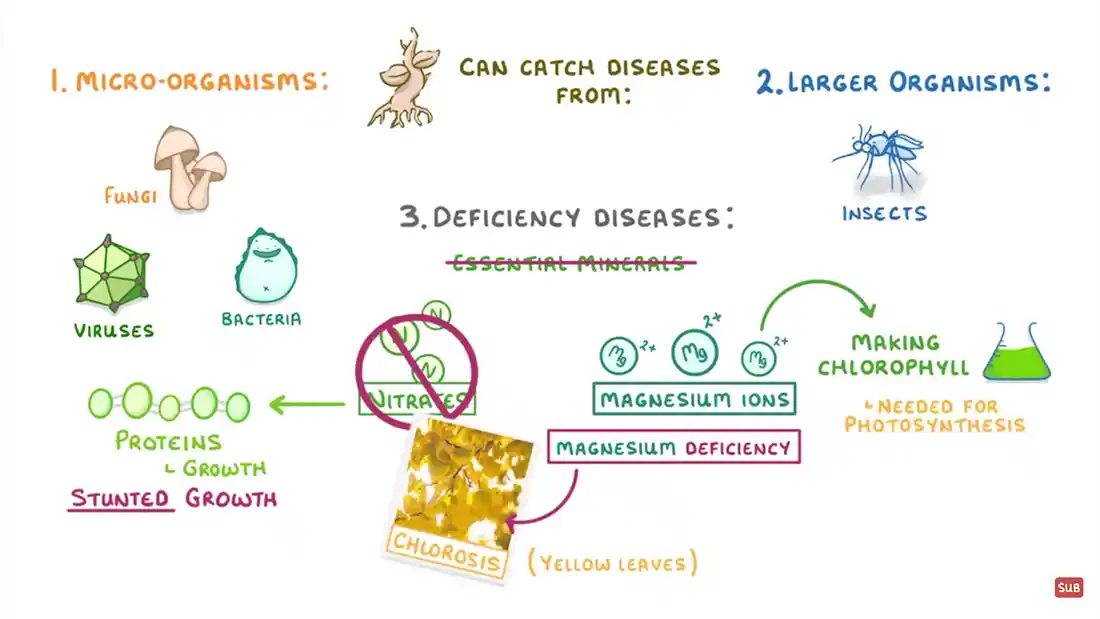

Lesion, disease, plants, fungal, bacterial, viral, protist, aphids, black spot, tobacco mosaic virus, photosynthesis, pathogen.
It's not just humans and animals that can catch diseases. Plants can too, and they could end up dying as a result of poor maintenance on our part. Plants can get a disease by catching them just like we do.
There are four types of pathogen that can cause diseases. They are:
You may have already covered diseases in humans, and recognise those key words, as they are the same. Yes, even plants are affected by the same types of pathogens as humans.
Plant pathogens work in similar ways to how they affect a human; they are spread through transmission, they infect and replicate or multiply within the host plant, once they have replicated enough, they can spread further to other hosts.
Where they are spreading, they can destroy crops in fields on a mass scale, or just the one or two plants you have in your garden.
A common virus in plants is the tobacco mosaic virus, or TMV. This infects plants, and other species such as tomatoes and peppers. This is spread by contact, so when a farmer touches a diseased plant with their hands and then another uninfected plant, for example.

A disease that can be spread from a plant to humans is called a zoonotic disease. They are similar in type (bacterial, fungal and viral) to what can be passed between plant to plant or human to human, and are also passed by the same methods.
This virus affects the plant's capability to photosynthesise, and stops it from growing as well as it should.
Another common disease in plants, and specifically in species of roses, a fungal pathogen called black spot affects the leaves by turning them black (hence the name) or purple. This in turn causes the other leaves to turn yellow and drop off, and can severely stunt the growth of rose plants.
The black spot is called a lesion. A lesion is a major change within parts of the body (for a plant, this can be the leaves, the stems, or the flowers) that can hurt it. It includes, wounds, sores, ulcers, tumors, cataracts and tissue damages. Where these apply to plants is in the fungal diseases and abnormalities of the plant which should not be there. In the case of black spot, this is an abnormality having darkened leaves and the inability to photosynthesis. It would be like taking both your lungs out of your body, and then requesting you to breathe. You just can't do it, unless you have a machine beside you doing it for you.
Although not a disease, they are very annoying, and can cause issues with a plant's growth. They will reside on the underside of leaves, on the stems and in the flowers of your favourite plants, and you can do as much as you like to get rid of them, but they will somehow manage to return.
They like to drink the sap and fluids, mainly glucose, from your plants, which is essential for the plant to grow. To combat them, you can use insecticides, but a more humane way is to use fairy liquid in warm water and a spray bottle. I've always found this works on mine, at least for a day or three.
OK, so we know about aphids, where they reside on the underside of leaves and eat away to stunt growth. They are also farmed by ants to harvest the plant sap from them in order for the ants to use them.
But what about combatting them without the use of insecticides?
Enter the ladybird. These little creatures start off as tiny larvae (usually a black and orange colour), and they eat the aphids. When they mature, they carry on doing the same job. They can eat up to 100 aphids a day.
So, gardeners will try and promote the health of their garden and plant ladybird-enticing plants. For me, I have lupins in the garden that the aphids love, but that also the ladybirds are also attracted to (mainly because of the aphids).
The following still is from a video on plant diseases, with the following details:
Please click on the image to view the video.

So, we know that plants can suffer from the same type (bacterial, fungal, viral and protist) of pathogen as humans, but what specifically are they?
Try and answer the following questions without looking first:
There is less chlorophyll, meaning that there is less glucose and starch. There is also less light absorbed and fewer chloroplasts.
Disclaimer | About Me | Sitemap
Website design by SyntaxHTML.



Blue icons adapted from icons courtesy of Smashicons.com